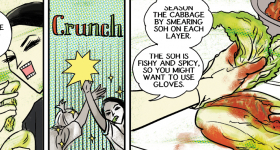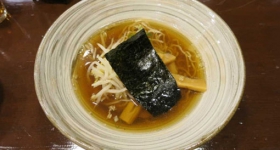My favorite holiday of the year is the day after Thanksgiving, that is, the day I get to use leftover scraps to make jook. I have been known to steal turkey carcasses and ham bones from holiday feasts, driving them over state lines on ice, excited for the real meal. Like most (maybe all?) of us in the APIA community, I don’t waste food. My grandma taught me better than that.
The wonderful thing about jook, or congee, is how adaptable it is. You need rice and you need liquid, preferably stock, but in times like these, with so little accessibility to groceries, you can also jazz up some water and that will do the trick. All other ingredients are optional and interchangeable. My Grandma Kam always made jook with turkey bones and the leftover shredded turkey meat—a simple and perfect take — drizzled with plenty of shoyu (soy sauce, for mainlanders) to add a salty bite. My mother would sometimes add cellophane noodles to the jook until it resembled Hawaiian chicken long rice, her favorite dish. I tend to get a little fussier with it, adding plenty of toppings and colors and crunch, depending on my mood. No matter what you use or don’t use, it is still the ultimate comfort food.
 One cup of rice will yield a lot of jook, so use a large pot or dutch oven for this recipe. I’ve rinsed my rice for a less starchy, looser version of jook, and I’ve also used rice as is, no rinse. Any white rice will do here, though I love to use sushi rice.
One cup of rice will yield a lot of jook, so use a large pot or dutch oven for this recipe. I’ve rinsed my rice for a less starchy, looser version of jook, and I’ve also used rice as is, no rinse. Any white rice will do here, though I love to use sushi rice.- Once your rice is in the pot, add approximately 10 cups of liquid. Stock is best here, but any liquid can be animated with dried mushrooms, shoyu, rice vinegar, mirin, chopped garlic, salt, white pepper, bonito flakes, shredded meat and/or crushed or chopped ginger knobs. Bring the rice/liquid combo to a light boil, and stir immediately.
- Lower the heat to a barely-there-simmer. The trick here is to continue stirring at least every 10 minutes. This is what builds that porridge-like texture. Don’t forget to scrape the bottom so nothing sticks or burns. If the jook thickens too quickly, go ahead and keep adding liquid (water is, again, just fine) to loosen it.
- While the jook simmers, I like to prepare toppings in a separate pan. Some topping ideas: boil some jammy eggs; fry up some fresh mushrooms with garlic and shoyu; chop some scallions, ginger matchsticks, leafy herbs, peanuts; sizzle some scallions or onions; quick pickle radishes or cucumbers with a simple salt/rice vinegar mixture; heat up fresh chili oil using Sichuan peppercorns or dried chilies. Anything goes. Make whatever you love.
- I usually reach the consistency I like at the 1-hour mark. Season the jook with salt, white pepper and shoyu to taste, though I always recommend a lot of shoyu; that’s our family way.
- Once I fill my bowl, but before I add any toppings, I always, always add a dash of acid to brighten the dish. I love a squeeze of lemon juice, or a drizzle of rice vinegar. After the vinegar, I love the addition of sesame and/or chili oil. Then, top away. Sesame seeds if you’re feeling fancy. Scrambled eggs if you’re a breakfast jook person (guilty). Build the bowl of your dreams. Enjoy, enjoy, enjoy.










Comments